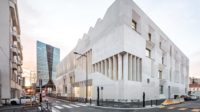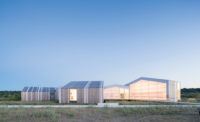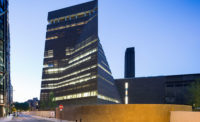Groupe Scolaire Louis de Vion by AAVP
Montévrain, France

Materials identify the components of the complex: white concrete for the single-story leisure center, and pine cladding on the elementary school’s south facade, where automated shutters act as shading devices. Pine also wraps the canopy of the adjacent white-concrete cafeteria block.
Photo © Luc Boegly

Wood rooftop enclosures contain mechanicals or tops of double-height spaces.
Photo © Luc Boegly

Preschool rooms, in artist James Turrell–inspired hues, adjoin gardens.
Photo © Luc Boegly

Grade-school and community center furnishings are bright and durable.
Photo © Luc Boegly

Its lobby features an oculus and offers views to the cafeteria block, where internal windows visually connect pre- and primary school dining areas.
Photo © Luc Boegly

The preschool faces an enclosed play yard, screened from the street by plantings.
Photo © Luc Boegly

The preschool faces an enclosed play yard, screened from the street by plantings.
Photo © Luc Boegly

Image courtesy AAVP

Image courtesy AAVP

Image courtesy AAVP










Architects & Firms
As architect Vincent Parreira walks around the Louis de Vion school complex in Montévrain, near Paris, his inclination to see from a child’s point of view quickly becomes apparent. He frequently drops to the ground to experience spaces as a child might, gazing up into a double-height volume as if from a preschooler’s sleeping mat, or exulting in a sky view from a window set below an adult’s line of vision. His concern goes beyond tailoring spaces to children’s physical stature, however: every aspect of the architecture is conceived to address their social and emotional needs.
School should be “a real universe in microcosm,” says Parreira, “a place that feels different from your house and the world outside—where there is a sense of surprise and possibility.” To make an environment in which children can feel secure and enjoy their independence, his instinct was to make an inward-looking campus with limited views in from or out to the street. This introversion was also suggested by the building’s context—or lack of it. Montévrain is a popular, fast-growing suburb whose dominant feature is the EuroDisney theme park, just visible from the school across farmland. Closer at hand, housing is now going up on all sides that wasn’t there when Parreira’s Paris-based office, AAVP, won the school project in a competition.
Additional Content:
Jump to credits & specifications
The 56,000-square-foot complex is sandwiched between a road and parallel pedestrian route, which follow the curve of a perfectly circular freeway that rings the Disney park. It comprises three separate facilities: an elementary school, a preschool, and a community center offering daycare outside school hours. The bulk of the program is arranged in a series of connected, two-story concrete and timber-frame structures along the pedestrian route. Behind that, a single-story wing for the preschool and a linked cafeteria block enclose a play yard for those young children. Another yard for the older students is open to the sunny southwest, but separated from the road by an obligatory parking lot. Where there are gaps between buildings, visual connections between the public and private realms are partly screened by densely planted gardens.
“We wanted to give the children a building like a castle, a dreamlike place,” says Parreira, “and the absence of windows to the outside and the material treatment of the facades help to give that impression.” The first-floor elevations are faced in white concrete and are largely blank, except for occasional diamond-shaped perforations over windows. The upper floor and several boxy rooftop enclosures for skylights and technical equipment are wrapped in a richly textured skin of pinewood. A tracery of diagonal timbers overlaid on a rainscreen of vertical slats extends the diamond motif. The depth of the facade suggests solidity, while its intricacy creates a lively play of shadows.
Parents accompany children as far as an anteroom at the entrance to each school. From there, children proceed alone into double-height halls that mark the true moment of arrival, each “an event in itself, like a miniature cathedral,” suggests Parreira. With a lean budget of around $240 per square foot and a strictly prescribed program, incorporating such exceptional spaces was challenging. For Parreira, however, they are essential: classrooms are highly regulated environments, both spatially and behaviorally, “so you need to create spaces outside that give children the freedom to speak and act as they want,” he says.
This was principally achieved in the circulation areas. Though the plan is conventionally economical, using internal corridors double-loaded with classrooms, Parreira was able to squeeze enough from the budget to increase the dimensions of these routes so that they also function as places to work or play. “The spaces are simple but have a lot of thought behind them,” says Parreira. “They represent the capacity to do something different.”
To create those differences, savings were made on finishes and fixtures. Inexpensive lighting and acoustic tiles are carefully arranged in patterns on classroom ceilings. While Parreira still detests using them, he notes there is compensation to be found for such compromises. For instance, he was able to increase the dimensions of a narrow corridor leading to a fire exit to make “a joyous space, with a window and enough room for a table and chairs.”
Other features intended to stimulate the senses and imagination were threatened by the risk aversion which increasingly characterizes environments made for children. AAVP argued successfully for exposed copper piping in bathrooms (“people worried that children would lick it”) and wide benches in the preschool cloakroom (a falling hazard). The client also had significant concerns over raw concrete walls in the elementary school corridors, but Parreira was determined to use it—in part to reclaim the material from negative associations of social deprivation—and, again, he prevailed.
Whatever the client’s initial misgivings, the municipality is pleased with the building. The mayor leads tours for visiting dignitaries, and Montévrain’s chief building official, Zoheir Bouakel, says, with approval, that “this building embodies a boundary between two worlds—light and shadow, wood and concrete, modernity and heritage.” It is also true, as Parreira readily admits, that others, including the principal (appointed after the building was completed), are less convinced by its material and architectural ethos. Nevertheless, he remains certain that the job of the school architect is to advocate for children, and that to enhance their freedom, the architect must himself “take some liberties.”
CreditsArchitect: Vincent Parreira Atelier Architecture AAVP 11, Cité de l’Ameublement 75011 Paris (FRANCE) +33 0144640505
Personnel in architect's firm who should receive special credit: Vincent Parreira, Baptiste Egea, Nicolas Fontaine Descambres,
Interior designer: Vincent Parreira
Engineers Structure engineering: DVVD Fluids engineering: LBE Roads and utilities engineering: ATEVE Building economics engineering: 12 ECO Acoustics engineering: ALTIA Landscape designers: ATELIER ROBERTA Sustainable development consultant: INGEROP Consultants Technical inspection : Qualiconsult Safety Coordinator : Namixis Health and safety protection coordination : Elyfec Control and coordination : Solutech – Corbice IDF
Photographer: Luc Boegly |
SpecificationsExterior Cladding Masonry: Cari Thouraud Metal panels: Cari Thouraud Metal/glass curtain wall: Moreau Rainscreen: Moreau Precast concrete: Jousselin Wood: Arbonis Moisture barrier: CIBETANCHE
Roofing Built-up roofing: Cari Thouraud / Arbonis Other: Cari Thouraud / Arbonis
Windows Wood frame: Moreau
Glazing Glass: Riou Glass Insulated-panel or plastic glazing: Cibetanche
Doors Entrances: La Fraternelle Metal doors: La Fraternelle Wood doors: La Fraternelle Sliding doors: La Fraternelle Fire-control doors, security grilles: La Fraternelle Special doors: La Fraternelle Upswinging doors, other: La Fraternelle
Interior Finishes Acoustical ceilings: E.P.H Suspension grid: E.P.H Demountable partitions: E.P.H Cabinetwork and custom woodwork: E.P.H Paints and stains: E.P.H Wall coverings: E.P.H Paneling: E.P.H Plastic laminate: DELCLOY Solid surfacing: DELCLOY Special surfacing: DELCLOY Floor and wall tile: DELCLOY Resilient flooring: DELCLOY Carpet: DELCLOY Raised flooring: DELCLOY
Lighting Interior ambient lighting: CEGELEC Downlights: CEGELEC Tasklighting: CEGELEC Exterior: CEGELEC Dimming system or other lighting controls: CEGELEC
Conveyance Elevators/escalators: A2S
Plumbing Each product has been manufactured by the manufacturer SITEME
Energy Energy management or building automation system: Gas + Electricity Other unique products that contribute to sustainability: Wood |
















